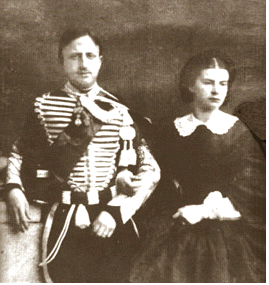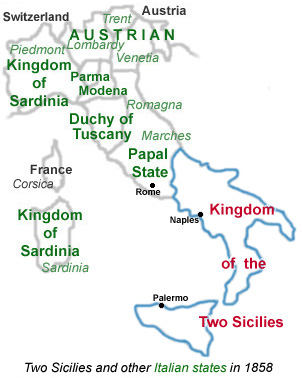...Best of Sicily presents... Best of Sicily Magazine. ... Dedicated to Sicilian art, culture, history, people, places and all things Sicilian. |
by Vincenzo Salerno | ||
Magazine Index Best of Sicily Arts & Culture Fashion Food & Wine History & Society About Us Travel Faqs Contact Map of Sicily |
Though he was groomed to be king, Francesco seemed more in his element when undertaking Christian works of charity and following a spiritual way of life as defined by the Catholic Church. Giuseppe di Lampedusa's description of the young king (in The Leopard) as a "seminarian" is not very far of the mark. Unfortunately, Francesco's noble-minded faith, and his unwavering loyalty to Pope Pius IX, justified such a characterisation. The simple reality is that kings must know when to be firm, and Francesco rarely did. In 1859 he wed the young Maria Sofia of Bavaria (their only child, a daughter born in 1869, died in infancy) Francesco ascended the throne upon the death of his father in May 1859. Carlo Filangieri, his prime minister, strongly urged him to accept the proposal of the King of Sardinia, Vittorio Emmanuel II of Savoy (a cousin and later King of Italy), to join a confederation of Italian states (similar to what was eventually formed in Germany), perhaps with Francesco as its sovereign. Ferdinando II had already refused such an offer. The impediment was Francesco's reluctance to occupy the Papal States or permit his Piedmontese counterpart, Vittorio Emanuele, to do so. Meanwhile, a number of disloyal military officers and political figures plotted an overthrow of the House of Bourbon with various Piedmontese agents. Foreign influence was also involved; when a force arrived at Marsala (western Sicily) led by Giuseppe Garibaldi, troops of Britain's Royal Navy, acting on orders, refused to intervene to stop him. Back in Turin (capital of the Savoys' Kingdom of Sardinia), Rosalino Pilo and Francesco Crispi, exiled Sicilian plotters of former conspiracies, supported Garibaldi's Sicilian invasion even as King Vittorio Emanuele II, at least officially, was at peace with Francesco II. The disloyalty of Sicilian officers sworn to defend the Kingdom of the Two Sicilies added to the debacle. Nevertheless, at this crucial point Francesco II could have intervened directly at the head of an expedition to Sicily and handily defeated Garibaldi's forces through use of what was, at that time, Italy's largest standing army. That he refused to do so spelled the end of his reign and wrote the destiny of Naples and Palermo as "secondary" cities of a nation to be ruled from Turin and then Rome. Instead, Francesco granted a belated constitution. With Garibaldi's crossing of the Strait of Messina into Calabria, Piedmontese
regular troops entered the invasion campaign directly. Francesco still could
have acted decisively but failed to do anything. In early September 1860,
in an event that strangly foreshadowed the Savoys' abandonment of Rome in
September 1943, Francesco, his consort and household, accompanied by a few
loyalists, left Naples. At Gaeta, a fortress overlooking the sea north of Naples near the border with the Papal States, Francesco held out as long as he could. At the Battle of Volturno in early October Neapolitan cavalry were overrun by Piedmontese troops, which were now invading the Papal States. A month later, in early November, the Siege of Gaeta began. Francesco surrendered the city on 12 February 1861 and the deposed king and queen departed for Rome. The by the Piedmontese began on November 6, 1860. Both Francis II and his wife behaved with great coolness and courage. Even when the French fleet, whose presence had hitherto prevented an attack by sea, was withdrawn, they still resisted. It was not until February 12, 1861 that the fortress capitulated. Alone among the "Thousand Cities" of the Two Sicilies, Messina had held out until the end of 1860, when the soldiers of its fort capitulated following heavy shelling. The royal couple lived in Austria, France, and Bavaria, and in Rome where their daughter was born and died. In 1894, Francis died at Arco in Trent (then Austrian but now northern Italy). Upon the death of Francis II, his half-brother, Prince Alfonso, became the Head of the House of Bourbon-Two Sicilies and de jure pretender to the throne of the Kingdom of the Two Sicilies. History is written by the victors. In defeat, Francesco II and his dynasty became the object of caricature and defamation by Italy's unificationists. Recent decades have witnessed a resurgence of interest in the culture and times of the Bourbon rule of Sicily (1734-1860), and Italian school history texts are beginning to correct the revisionist history of the "Risorgimento" (unification movement) to reflect more accurately Italy's pre-unitary history. About the Author: Palermo native Vincenzo Salerno has written biographies of several famous Sicilians, including Frederick II and Giuseppe di Lampedusa. | |
Top of Page |
 Francis (Francesco)
II of the Two Sicilies reigned briefly (1859-1861) as the last king of Naples
and Sicily before Italian unification. He died in exile in 1894 aged only
58, partly due to complications from diabetes. Born in Naples in 1836, Francesco
was the only child of King Ferdinando (Bourbon) II of the Two Sicilies and
his first wife, Maria Cristina of Savoy; the living members of the
Francis (Francesco)
II of the Two Sicilies reigned briefly (1859-1861) as the last king of Naples
and Sicily before Italian unification. He died in exile in 1894 aged only
58, partly due to complications from diabetes. Born in Naples in 1836, Francesco
was the only child of King Ferdinando (Bourbon) II of the Two Sicilies and
his first wife, Maria Cristina of Savoy; the living members of the 